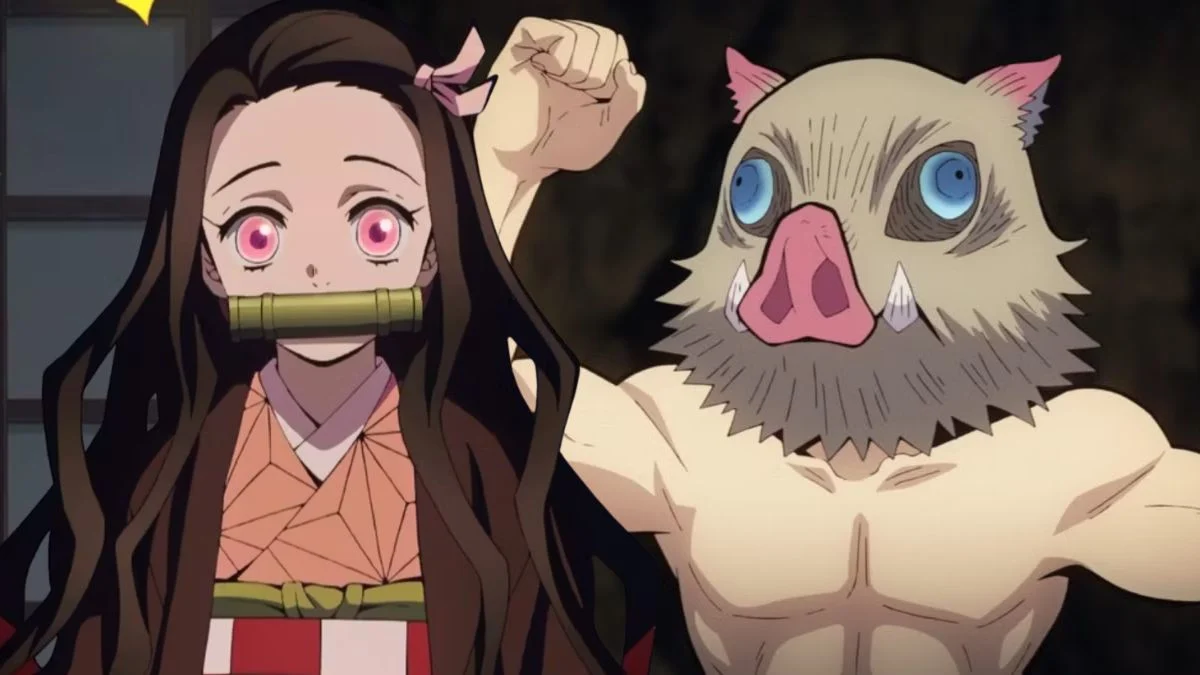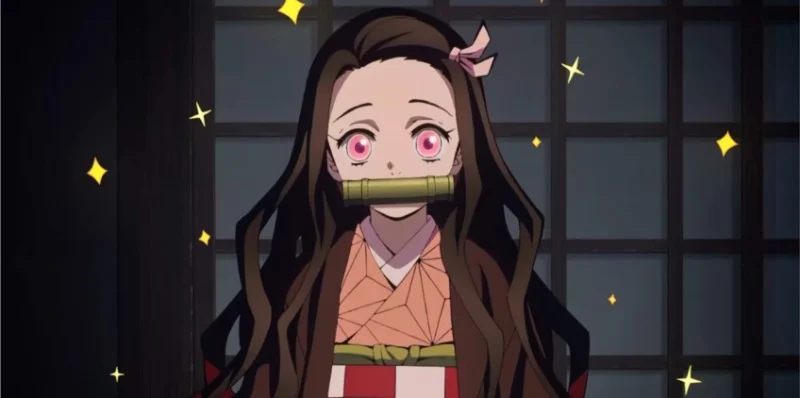
‘Demon Slayer’ is visually stunning and features incredibly well-done action sequences, so it’s easy to overlook minor flaws. However, observant viewers might notice small inconsistencies in the animation, continuity errors, or plot points that don’t quite add up. These aren’t major problems, just the kind of little details that dedicated fans enjoy spotting.
Throughout story arcs like ‘Final Selection’, ‘Mugen Train’, ‘Entertainment District’, and ‘Swordsmith Village’, you can find various errors – from objects changing position to inconsistencies with how light appears. Below, we highlight these moments as they happen in the show, so you can check them out for yourself when you rewatch.
Hanafuda earrings that change between shots

Throughout the *Demon Slayer* series, Tanjiro’s hanafuda earrings occasionally show small differences in their design. These changes—like petals appearing wider or the sun symbol shifting slightly—are most noticeable during fast-paced action and flashback scenes. Viewers have spotted these quick alterations as the camera switches between close-up and wider shots within the same scene.
You can most easily spot the changes in bright, outdoor scenes, especially when the earrings take up a large part of the screen. Pay attention during important moments like the ‘Final Selection’ and confrontations – if you watch closely when Tanjiro turns his head, you’ll see the earring designs sometimes appear simpler and other times more detailed, even within the same scene.
Nezuko’s bamboo muzzle that quietly resizes

The length of Nezuko’s bamboo muzzle seems to change a bit depending on the camera angle in the show. Sometimes it looks shorter, almost touching her cheek, and other times it appears longer, extending past her jaw. The way the straps holding it in place also look a little different depending on the shot.
Noticeable changes in the size of objects often occur when the camera angle shifts from a side view to a three-quarter view, especially during quick conversations. This is most apparent in quieter moments, like scenes at Urokodaki’s house, or during lulls in fighting when Nezuko looks at Tanjiro, and the length of the bamboo muzzle seems to change slightly.
Nichirin blade details that reset mid fight

As a big fan of the fight scenes in this show, I’ve noticed something a little odd with the swords. They definitely *look* damaged during battles – you see nicks and dirt build up, which is great for realism. But sometimes, a sword will be all scratched up in one shot, then perfectly clean a moment later, even though there’s no time for anyone to maintain them! It’s most noticeable with Zenitsu’s lightning sword and Inosuke’s unique, chipped dual blades – those designs really stand out. I’ve even spotted chips on Inosuke’s swords disappearing and then magically reappearing later in the same fight. It’s a small detail, but it can be a bit distracting.
This issue frequently appears during quick cuts between close-up sword fights and wider action shots. You can see it in the fast-paced scenes of ‘Mugen Train’ and the ‘Entertainment District Arc’ – look for moments where the camera moves around a character and the sword’s texture briefly appears sharper and cleaner.
Sunlight rules that get a little flexible

The series consistently shows that demons are instantly destroyed by direct sunlight. However, some earlier scenes depict Nezuko partially exposed to sunlight while traveling, with beams of light passing through the gaps in her basket. In these moments, light shines on her face at certain angles, yet the very next shot shows her completely shaded, despite the basket’s position remaining the same. There are also a few instances where daylight near doorways nearly touches Nezuko without causing any reaction.
You can often notice these inconsistencies while watching scenes set during daytime drives or outdoor village shots, before characters are consistently wearing things like coats or hats. It looks like bright spots of light hit someone’s skin in one shot, then they’re completely in shadow in the next, suggesting the lighting changed between those two shots.
Visible breath effects in scenes set in warm conditions

As a real cinema lover, I’ve noticed something a bit odd in a few films lately. They’re adding these stylized breathing effects – like wisps of vapor – to characters, and sometimes you even *see* their breath in scenes that don’t really call for it. I was watching one movie where a character was clearly in a mild climate, surrounded by green plants and sunshine, but they were visibly breathing out white plumes of mist. Then, the very next shot, everyone else in the same scene *wasn’t* breathing mist, even though nothing about the temperature or what they were wearing seemed to have changed! It just appears and vanishes so quickly, and it’s a little distracting.
You’ll especially notice this during outdoor scenes with clear skies, like training or fights on cliffs. Keep an eye out for moments where you can see a character’s breath in a close-up shot, but then it disappears when the camera pulls back, even though other characters are doing the same amount of physical activity.
Crows that deliver messages with improbable timing

The Kasugai crows are used to deliver important messages quickly, even over long distances. However, sometimes they arrive right after a battle ends, despite the party being far from the nearest town. This creates a disconnect, as it would realistically take time to write and send such detailed orders. It makes the crows seem much faster than the scenes showing travel would indicate.
You’ll notice this happening when the story jumps from one major event to the next, with the characters getting new instructions right after dealing with a previous problem. It makes it seem like information travels incredibly quickly – the crow can reach the group and deliver messages in a much shorter time than it took for similar journeys in earlier parts of the story.
Wounds that migrate a few centimeters

During action scenes, cuts and wounds can appear to move a little when the camera angle changes. For example, a cut across the chest might seem higher or closer to the shoulder in a different shot, or a bandage might cover an injury that was visible elsewhere before. This often happens because of how clothing folds and shifts as characters move and fight.
You can really notice this effect during longer fights when a character gets a distinct wound. That injury then acts as a visual guide for where subsequent blows land. Pay attention to the later battles in the ‘Mugen Train’ and ‘Entertainment District Arc’—you’ll see the same injury appear in slightly different positions depending on the camera angle.
Uniform damage that heals between cuts

Demon Slayer Corps uniforms get visibly damaged during battles, with rips and tears appearing on sleeves and seams. However, the animation cleverly fixes these tears briefly – for example, a ripped hem will look clean for a moment after a landing, but quickly revert to its damaged state when the character moves again. The unique patterns on the haori cloaks make it obvious when these temporary fixes happen, as any missing pieces remain consistently absent.
This often happens in scenes that combine traditional animation with lots of visual effects. Notice how Tanjiro’s and Zenitsu’s patterned jackets appear to change – their edges sometimes look worn and damaged, and other times perfectly fine – during fights with multiple enemies, as the camera angle shifts.
Demon regeneration speed that varies within the same exchange

I’ve been really enjoying the show, but I’ve noticed something a little odd with how the demons heal. It’s established that stronger demons take longer to regenerate, which makes sense. However, there are moments where the same demon will instantly grow back an arm after being cut off, and then *immediately* after, when cut again, it takes a much longer time – even though nothing seems to have changed in terms of how much damage they took or how much effort was used against them. I’ve seen an arm fully reattach for an attack, only for it to revert to a half-formed stump in the next shot, taking several moments to fully heal. It’s a little jarring and breaks the consistency of their regeneration ability.
You’ll notice this effect during nighttime fights when the camera shows attackers moving around their target. The demon’s health bar will visibly jump up and down, especially when several players hit it quickly, making its health appear to fluctuate with each camera angle.
Inosuke’s boar mask with shifting eye openings

Inosuke’s boar mask changes shape with his expressions – the eye holes get bigger or smaller. However, in some scenes, the mask stretches and shrinks more dramatically than usual, revealing much more of his face before quickly returning to its normal size. The lines where the snout connects to the mask also move along with these changes, then settle back into place when the camera angle shifts.
You can see these subtle changes during intense moments, like when characters are taunting each other or talking during a fight. Pay attention to early interactions with Tanjiro and scenes from the ‘Entertainment District Arc’ – the mask’s expression will briefly become more open, showing a reaction, and then quickly return to its usual tighter appearance.
Let us know about any small mistakes or funny details you’ve noticed in ‘Demon Slayer’ in the comments below! Everyone can then try to spot them when they watch the show again.
Read More
- Silver Rate Forecast
- Gold Rate Forecast
- Красный Октябрь акции прогноз. Цена KROT
- MSCI’s Digital Asset Dilemma: A Tech Wrench in the Works!
- Dogecoin’s Big Yawn: Musk’s X Money Launch Leaves Market Unimpressed 🐕💸
- Bitcoin’s Ballet: Will the Bull Pirouette or Stumble? 💃🐂
- Guardian Wealth Doubles Down on LKQ Stock With $1.8 Million Purchase
- Binance and Botim Money Join Forces: Crypto in the UAE Gets a Boost-Or Does It? 🚀
- Twenty One Capital’s NYSE debut sees 20% fall – What scared investors?
- Monster Hunter Stories 3: Twisted Reflection gets a new Habitat Restoration Trailer
2025-10-15 11:14